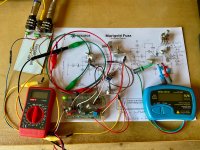JHKcustoms
Member
just completed my Marigold Fuzz build and I’ve got some weirdness,
First of all my tone knob seems to work backwards, ie it’s more trebly to the left and more bassy to the right, I’m not sure if this is a thing or not but it’s odd.
The other thing is that it seems to be “ducking” kinda like a limiter when playing it,
So if I strike the strings it kinda ducks and comes back to volume wise when I let the note sustain.
I’ve got plenty of volume out of it, the fuzz pot also works normally, like I say the tone seems to operate backwards.
Been testing this on the “auditorium” test platform which by the way is so so useful!
Here’s a few gut shots
First of all my tone knob seems to work backwards, ie it’s more trebly to the left and more bassy to the right, I’m not sure if this is a thing or not but it’s odd.
The other thing is that it seems to be “ducking” kinda like a limiter when playing it,
So if I strike the strings it kinda ducks and comes back to volume wise when I let the note sustain.
I’ve got plenty of volume out of it, the fuzz pot also works normally, like I say the tone seems to operate backwards.
Been testing this on the “auditorium” test platform which by the way is so so useful!
Here’s a few gut shots








